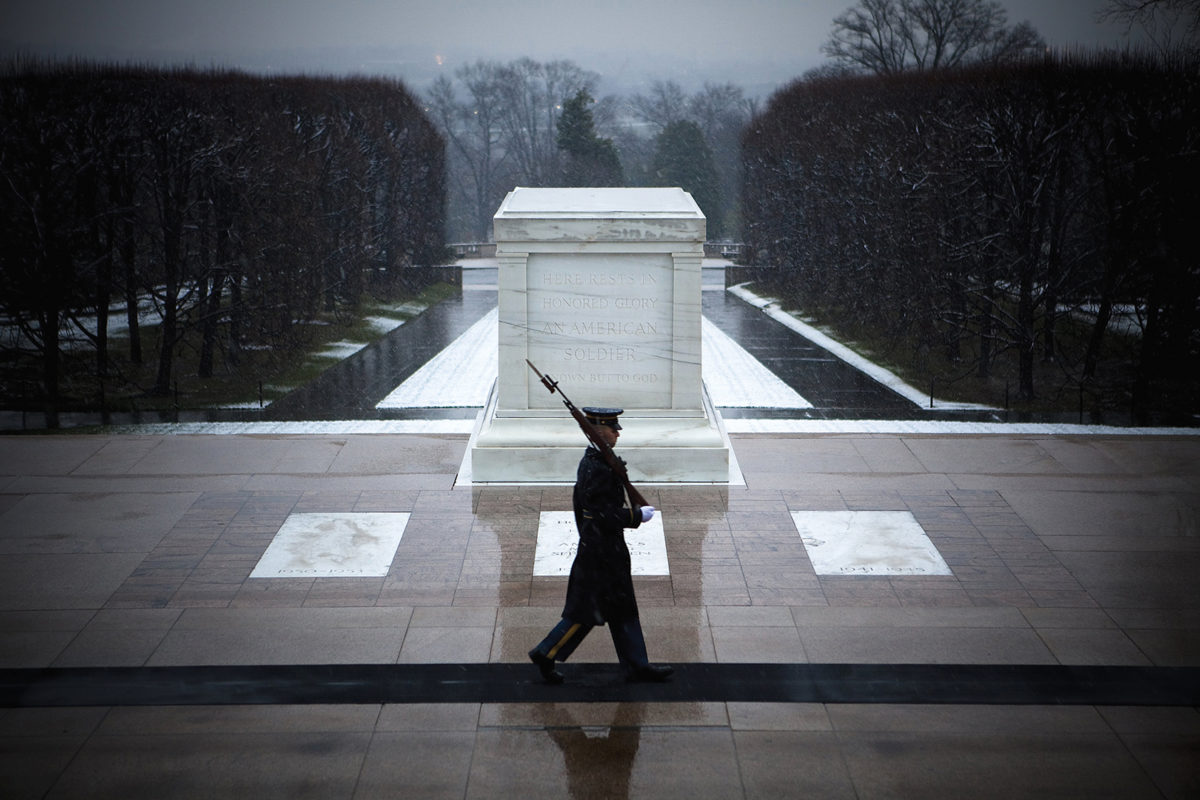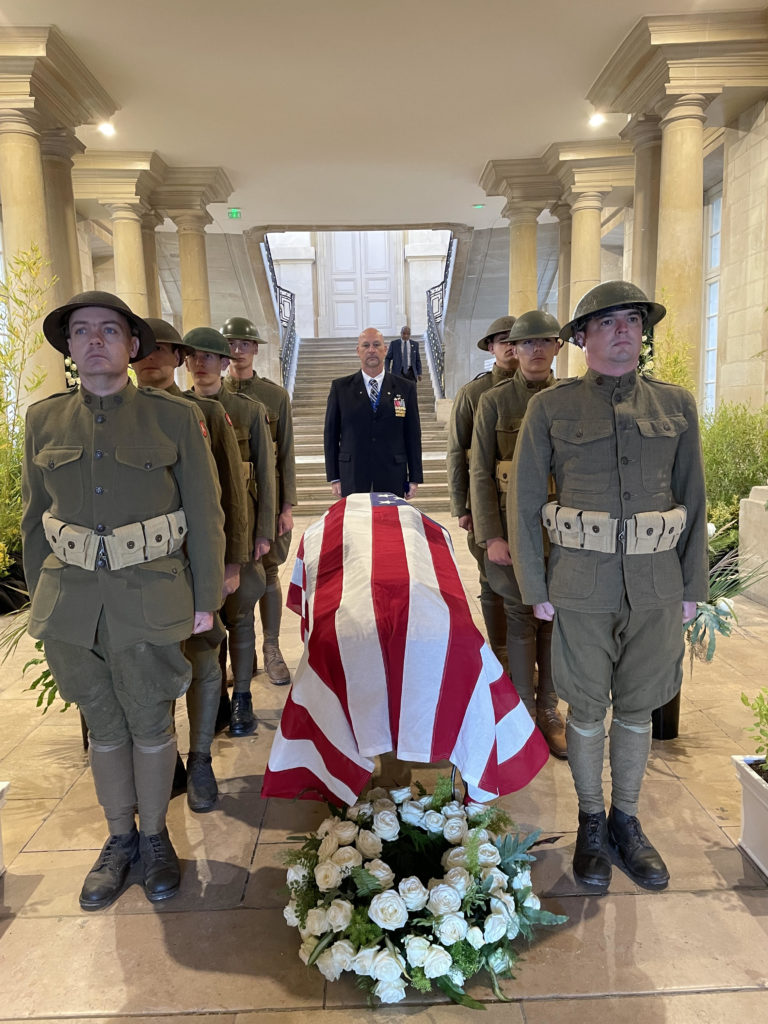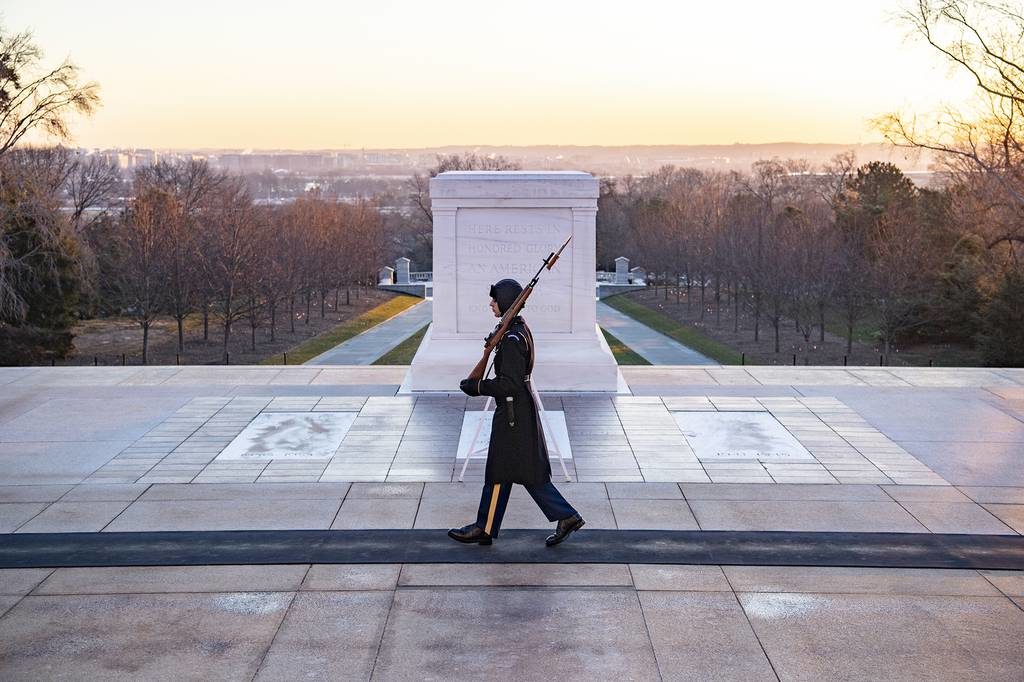The Tomb of the Unknown Soldier, overlooking Washington from a hill at Virginia’s Arlington National Cemetery, has come to symbolize the sacrifices of all U.S. service members who died in war, not just the unidentified ones buried there. The tomb is hallowed ground with burials extending from World War I through the Vietnam War, but the Vietnam section, much like the war itself, has been marked by controversy and turmoil.
The memorial’s storied history began on March 4, 1921, when President Woodrow Wilson, on his last day in office, signed legislation directing the secretary of war to bring to the United States “the body of an unknown American” who served in Europe during World War I “for the burial of the remains with appropriate ceremonies” in Arlington National Cemetery.
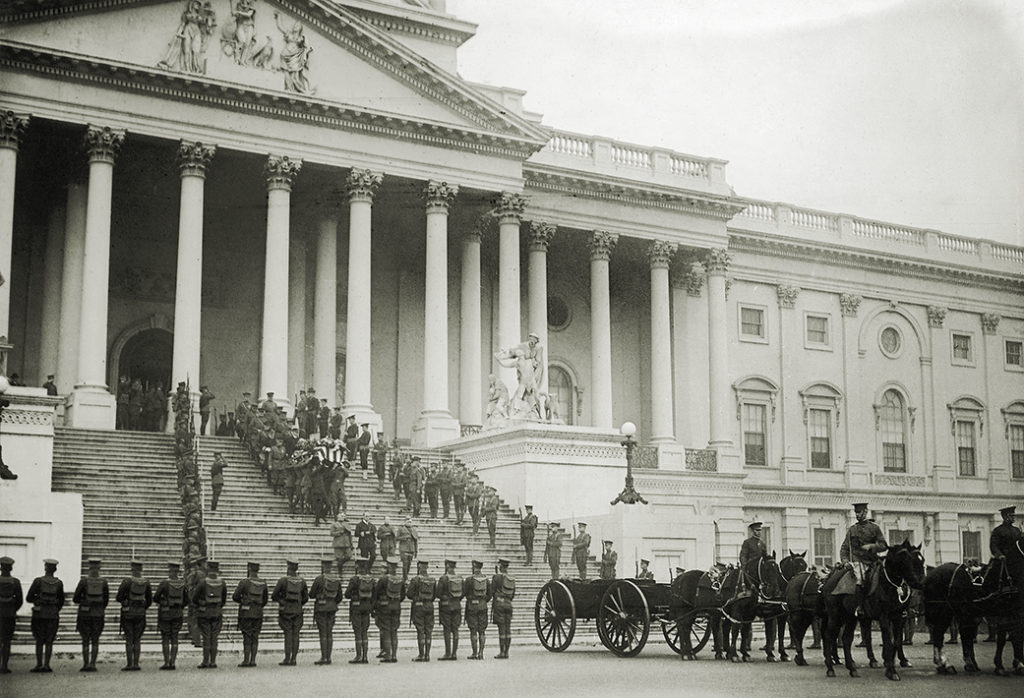
In September that year, four identical caskets were exhumed from unmarked battlefield graves in France. On Oct. 24, they were transported to city hall in Chalons-sur-Marne. One would be selected for the Arlington tomb. Sgt. Edward Younger, a World War I veteran, was chosen to make the selection. He laid a spray of white roses on his choice. The selected casket was transported to Washington, aboard the armored cruiser USS Olympia. The other three caskets were reinterred in the Meuse-Argonne American Cemetery.
Recommended for you
The selected casket arrived in Washington on Nov. 9, 1921, and lay in state on the Lincoln catafalque at the Capitol rotunda for two days. Some 100,000 visitors, including President Warren G. Harding and first lady Florence Harding, lined up to pay their respects. On Nov. 11, exactly three years after the armistice ending the war was signed, Harding officiated at a burial ceremony attended by more than 5,000 people, including members of Congress, foreign dignitaries, generals, Medal of Honor recipients, other soldiers and veterans. After the national anthem, Harding addressed the crowd and then placed the Medal of Honor and the Distinguished Service Cross on the casket. Foreign dignitaries added more medals.
The casket was moved to the crypt site east of the cemetery’s Memorial Amphitheater, dedicated in May 1920. As a cannon battery fired three volleys, it was lowered into the crypt under a simple white marble monument. Construction on the official Tomb of the Unknown Soldier that visitors see today began in December 1929 and was completed in April 1932.
Protected Ground
In 1926, Congress directed that the memorial be protected by a military guard during daylight hours. In July 1937, the guard was extended to 24 hours. Sentinels from the 3rd U.S. Infantry Regiment, “The Old Guard,” assumed those duties in April 1946. They have maintained a constant vigil ever since, regardless of weather conditions.
After World War II and the Korean War had both concluded, President Dwight D. Eisenhower signed a bill in August 1956 to pay tribute to the unknowns of the two wars. The Army exhumed 18 bodies from cemeteries in North Africa, Europe, the Philippines and Hawaii.
One casket was chosen to represent soldiers who fought in Europe; another was selected to represent the Pacific theater. From those two, the casket destined for Arlington was selected. The other World War II unknown was buried at sea in a solemn ceremony. For the Korean War representative, Army officials chose one casket from four exhumed at the National Memorial Cemetery of the Pacific in Honolulu.
On May 28, 1958, the casket bearing the unknown from World War II and the casket from Korea arrived in Washington. They lay in state at the Capitol rotunda until May 30, taking turns on the Lincoln catafalque. On May 30, Memorial Day, the caskets were borne by Army caissons to the Arlington cemetery. During a ceremony with full military honors, they were interred in crypts prepared for them alongside their World war I comrade. Eisenhower placed the Medal of Honor on each casket. A 21-gun salute was fired. The casket teams folded the flags and presented them to Eisenhower and Vice President Richard Nixon, who stood in for the unknowns’ next of kin.
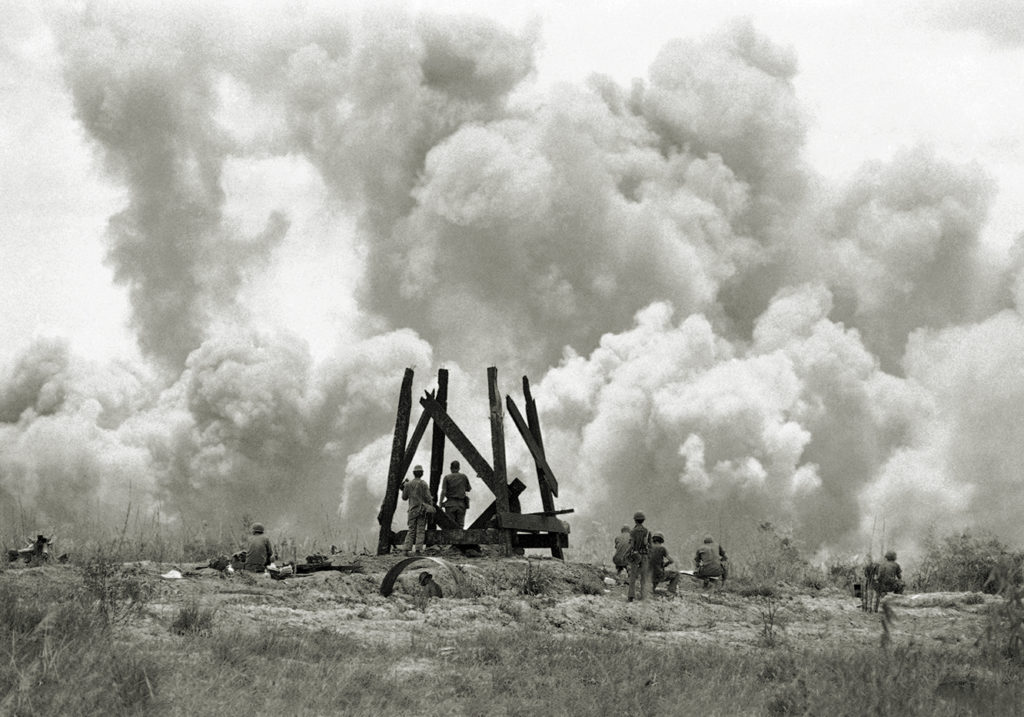
Vietnam Involvement
In the early 1960s, the United States found itself at war in Southeast Asia. After the commitment of U.S. ground troops in 1965, the war became increasingly unpopular at home and divided the nation. Nixon, elected president in 1968, announced in 1969 that he would begin withdrawing troops and seek a negotiated peace with the North Vietnamese. The Paris Peace Accords were signed on Jan. 27, 1973, and all U.S. troops were out of South Vietnam by the end of March. The South Vietnamese fought on alone until the spring of 1975, when the North Vietnamese ultimately triumphed.
National leaders agonized over a way to commemorate the conflict and honor Americans who had fought in Vietnam. In 1978, President Jimmy Carter dedicated a plaque at the Memorial Amphitheater in Arlington to commemorate those missing in action from the Vietnam War.
Ronald Reagan, inaugurated president in January 1981, wanted to inter an unknown soldier from the Vietnam War at Arlington. However, there were few unknowns among the Vietnam War dead because of technological advances that aided in the identification of remains. But Reagan was adamant. He believed a Vietnam representative at the tomb would be a way to honor all of the war’s veterans.
There was opposition, however, from various quarters, including the National League of Families of American Prisoners and Missing in Southeast Asia, whose members believed that a memorial to an unknown Vietnam soldier might be a politically expedient way to close the book on the MIA issue.
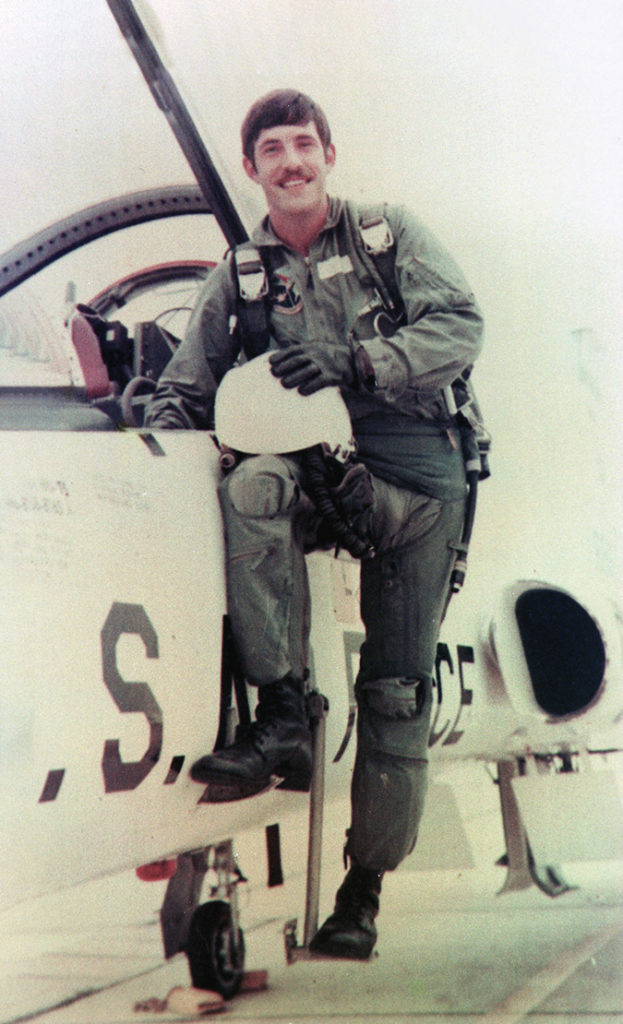
Despite the opposition, Congress passed a law in 1983 authorizing the Defense Department to designate a Vietnam unknown to be buried at Arlington National Cemetery. Four sets of remains were candidates. Two were subsequently identified and sent home to their families. The third was disqualified because of some uncertainty about the circumstances of his death. That left the remains that had been identified as X-26.
Who Was Michael Blassie?
The X-26 remains were recovered at the site of an Air Force plane shot down on May 11, 1972, in the area of An Loc, a town near the Cambodian border about 65 miles north of Saigon. The pilot was 1st Lt. Michael J. Blassie.
Blassie, the oldest of five children, was born in St. Louis on April 4, 1948, to George and Jean Blassie. His father had served in Normandy during World War II. After graduating from St. Louis University High School, Blassie entered the U.S. Air Force Academy at Colorado Springs, Colorado. He studied psychology and was nominated for the All-Rocky Mountain League Soccer Team in 1968. Blassie graduated in 1970. After flight training at Columbus Air Force Base in Mississippi, he received orders for the 8th Special Operations Squadron in Vietnam.
Blassie had already flown 132 combat missions when he took off from Bien Hoa Air Base near Saigon in his Cessna A-37B Dragonfly light attack aircraft on May 11, 1972. He flew northwest toward An Loc, the site of heavy fighting since early April, when three North Vietnamese divisions besieged the city as part of Hanoi’s 1972 invasion launched over Easter weekend and known as the Easter Offensive.
South Vietnamese defenders in An Loc, led by the commander of the Army of the Republic of Vietnam’s 5th Division, had turned back repeated attacks with help from massive amounts of U.S. air power. On May 10-11, the North Vietnamese began what would be their strongest push to take the city. The defenders were vastly outnumbered. The enemy, attacking with nine regiments, forged two salients in the ARVN lines. With the South Vietnamese troops in a desperate situation, all available air support was rushed to the area.
How Did Michael Blassie Die?
Blassie and his flight commander, Maj. Jim Connolly, were both flying in aircraft armed with two 500-pound napalm bombs and assorted other munitions for a strike on enemy gun emplacements north of An Loc. Blassie rolled in against the enemy position. Before he could complete his low-level run, the Cessna was hit by a stream of tracer rounds from an enemy anti-aircraft battery.
In a letter to Blassie’s parents, Connolly described what happened: “Mike’s aircraft was hit and began streaming fuel. He must have been killed instantly, because he did not transmit a distress call of any kind. The aircraft flew a short distance on its own and then slowly rolled over, exploding on impact in enemy-held territory.”
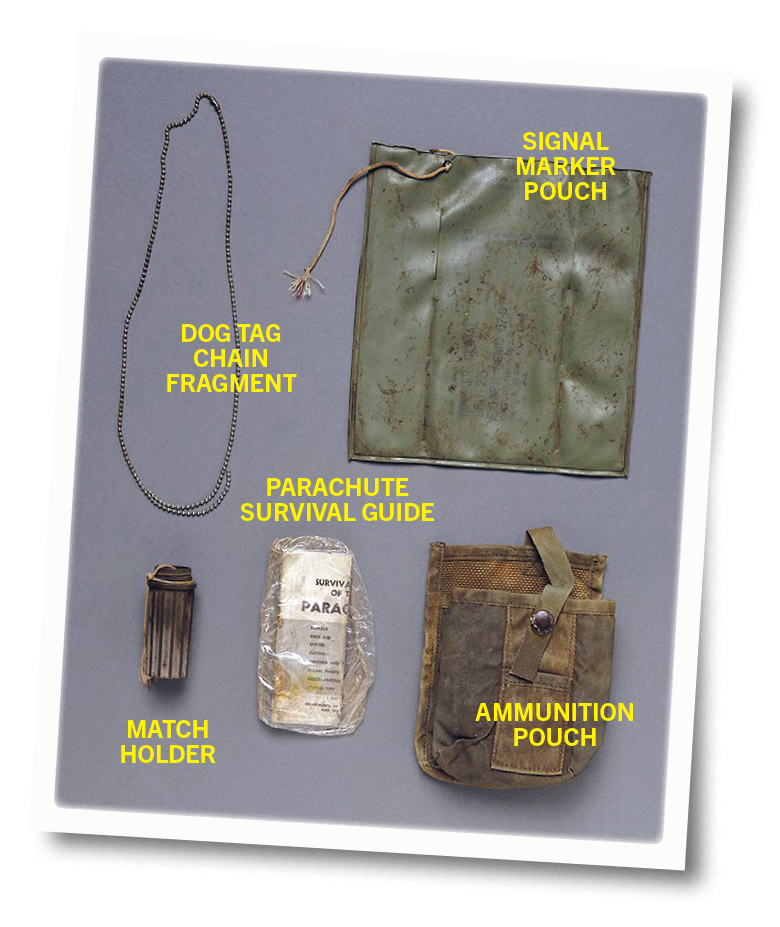
Connolly requested Army Bell AH-1Cobra helicopters to search the crash site, but the choppers encountered heavy groundfire and had to abort the search. Connolly believed there was no way Blassie could have survived, but the major continued circling the area “until the last hope faded and all other aircraft departed,” he said later.
The day after the crash, an Air Force chaplain visited Blassie’s parents in St. Louis and told them their son had been killed in action and his body could not be recovered.
How Were Michael Blassie’s Remains Recovered?
Fighting continued around An Loc for five more months, precluding any search of the crash site. On Oct. 11, after South Vietnamese troops turned back the North’s offensive and began to push their lines out from An Loc, an ARVN patrol found the crash site. They recovered six human bones and an assortment of other physical evidence, including a beacon radio, part of a pistol holster, a portion of a parachute and a flattened one-man life raft. The search also found fragments of a flight suit, a wallet containing Blassie’s ID card and a photograph of his family.
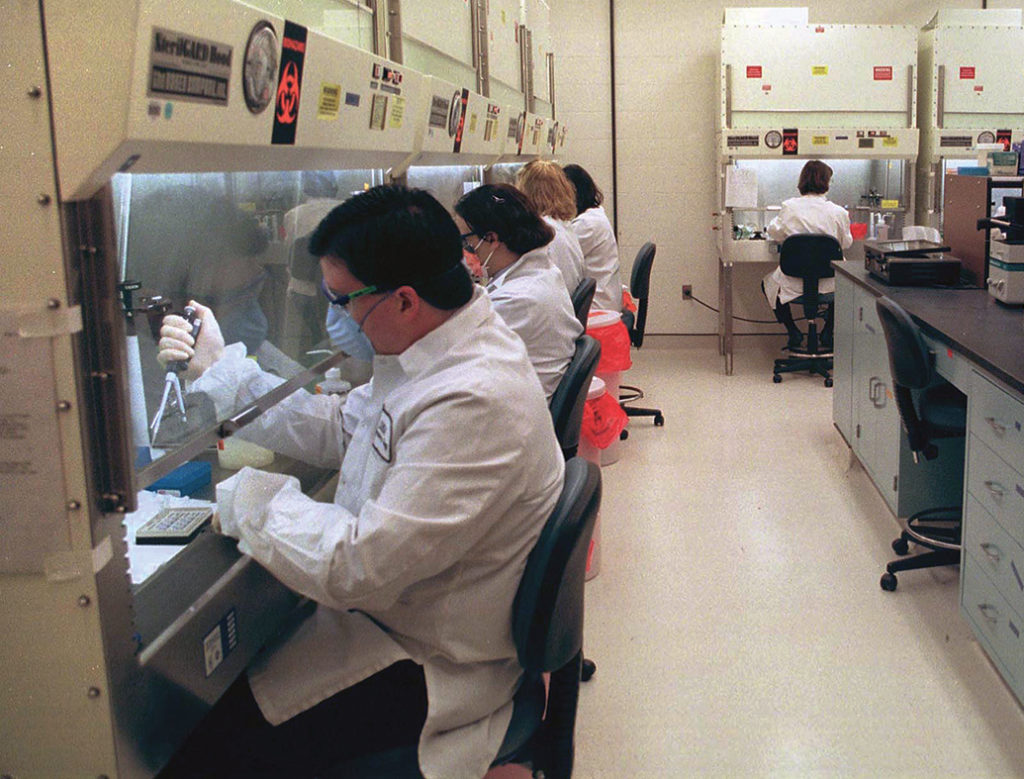
The South Vietnamese placed the remains and physical evidence in bags and gave them to Capt. Bill Parnell, an adviser with the ARVN 18th Division, which had replaced the 5th Division as the controlling headquarters in An Loc. On Nov. 2, the remains were transported to a mortuary at Tan Son Nhut Air Base just outside Saigon. However, during the trip, Blassie’s wallet, including his ID card and a small amount of cash, disappeared.
Although the evidence that still existed suggested the remains were those of Blassie, personnel at the Tan Son Nhut mortuary determined that it was not enough for a definitive forensic identification. Therefore, Blassie’s family was not informed that remains and artifacts had been recovered from the crash site. In 1973, the remains, associated evidence and related paperwork were transferred to a search and recovery center at Camp Samae San, Thailand.
What Was the Controversy over Michael Blassie’s Remains?
In 1976, the remains were transferred to Hawaii for analysis at the Army’s new Central Identification Laboratory, responsible for identifying Vietnam war dead. Based on the evidence associated with the human remains, the recovered bone fragments were initially designated as “Believed To Be” Michael J. Blassie.
However, that designation was reversed after an examination of the human remains by Tadao Furue, the Hawaiian facility’s chief physical anthropologist, who had been identifying Korean War casualties since 1951. In cases where he had little information to work with, Furue attempted to calculate age, height and other characteristics by measuring bone fragments, a controversial technique called “morphological approximation,” which was later discredited.
In a memorandum dated Dec. 4, 1978, Furue wrote that after “processing” the remains from the Blassie crash, he estimated the bones belonged to an individual between 26 and 33 years old. Since Blassie was 24 years and 7 months old at the time of his death, Furue determined that he was outside “the estimated age bracket.” Additionally, he estimated height at time of death as 65.2 to 71.5 inches. Blassie was 72 inches. Furue tested a single hair found in a portion of the recovered flight suit and determined that the “blood type of the remains disagrees with the recorded blood Type ‘A’ for Blassie.”
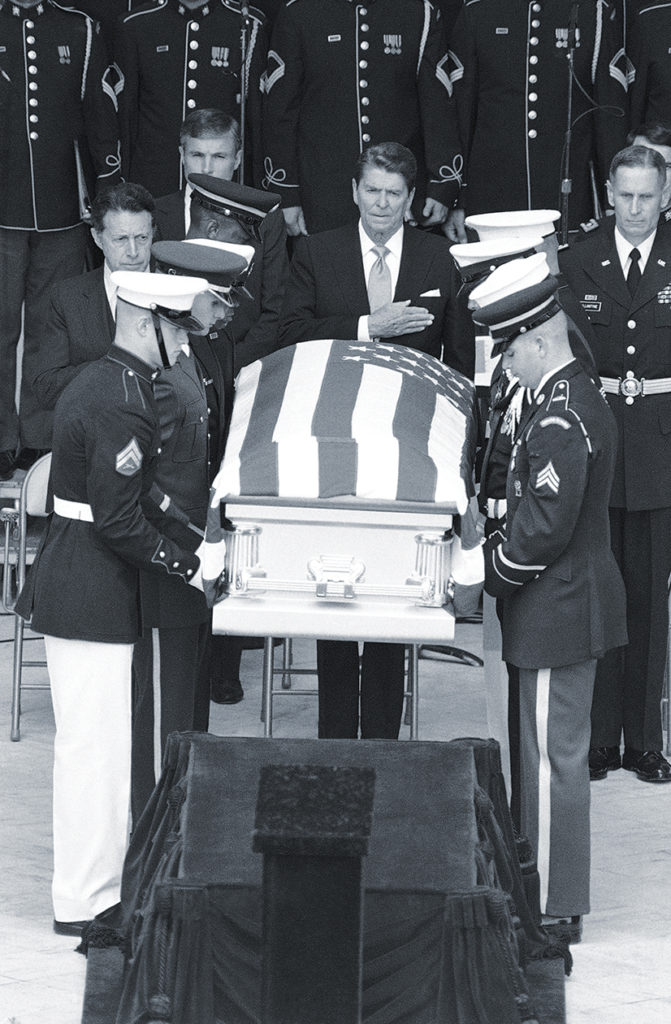
Disregarding the documents that accompanied the remains, which indicated they might be those of Blassie, Furue was convinced that the remains were inconsistent with what was known about Blassie. He recommended that the bones be reclassified as “designation unknown.” In 1980, the Armed Services Graves Registration Office accepted Furue’s recommendation, and the “believed to be” status was rescinded. The remains were reclassified as “unidentified.” They were given the file number TSN 0673-72 X-26 (the “X” designation took the place of Blassie’s name) and stored at a lab in Hawaii.
There was pushback from some senior personnel at the lab. Maj. Johnnie Webb, the officer in charge of the Central Identification Lab, refused to sign documents that said the X-26 remains were unidentifiable. He believed the evidence sufficiently identified the remains as those of Blassie. The Pentagon told Webb in 1983 that he had six months to positively identify the remains of X-26 or certify that they were unidentifiable. Unable to conclusively prove that the remains were those of Blassie, Webb reluctantly certified on March 21, 1984, that the remains could not “support a positive identification with any known casualty” in Vietnam.
The Pentagon ordered Webb to destroy any evidence linking Blassie to the X-26 remains. Instead, he hid the crash-site artifacts in the casket with the human remains. Webb then penned a letter to the assistant secretary of the army discussing the controversy over the X-26 remains and described evidence that linked them to a particular pilot, although he did not specifically name Blassie. Later, Secretary of the Army John O. Marsh said he never saw Webb’s letter to the assistant secretary.
Blassie’s REmains the the Tomb
In a ceremony at Pearl Harbor on May 17, 1984, Marine Sgt. Maj. Allan Jay Kellogg Jr., a Medal of Honor recipient from the Vietnam War, placed flowers on the casket containing the X-26 remains. The casket was transported to the frigate USS Brewton, which sailed into San Francisco Bay’s Alameda Naval Air Station on May 24. The casket was offloaded with full honors, including a 21-gun salute and a flyover by fighter jets. It was taken to nearby Travis Air Force Base and put aboard a cargo aircraft for transport to Andrews Air Force Base outside Washington.
The casket containing the X-26 remains lay in state in the Capitol rotunda for three days. The president and first lady Nancy Reagan paid their respects while it was there. On Memorial Day, May 28, 1984, the casket was borne by a horse-drawn caisson to Arlington National Cemetery. An estimated 250,000 people lined the procession route. Reagan presided over an interment service with some 3,000 guests, including more than a hundred veterans, some in wheelchairs and others on crutches. Also attending were families of service members still missing in action.
Reagan said: “The unknown soldier who has returned to us today … is symbolic of all our missing sons. Today we pause to embrace him and all who served us so well in a war whose end offered no parades, no flags and so little thanks.” The president promised that the United States government would never stop searching for those still missing, no matter how long it took.
Reagan then placed the Medal of Honor on the flag-draped casket and said, “Thank you, dear son, and may God cradle you in his loving arms.” The president accepted the American flag from the Honor Guard on behalf of the unknown’s loved ones. The casket was buried in a crypt alongside the unknowns from World War I, World War II and Korea. A marble slab was placed over the crypt, inscribed with “1958-1975.” The Blassie family in St. Louis had no idea that their loved one was buried in that crypt.
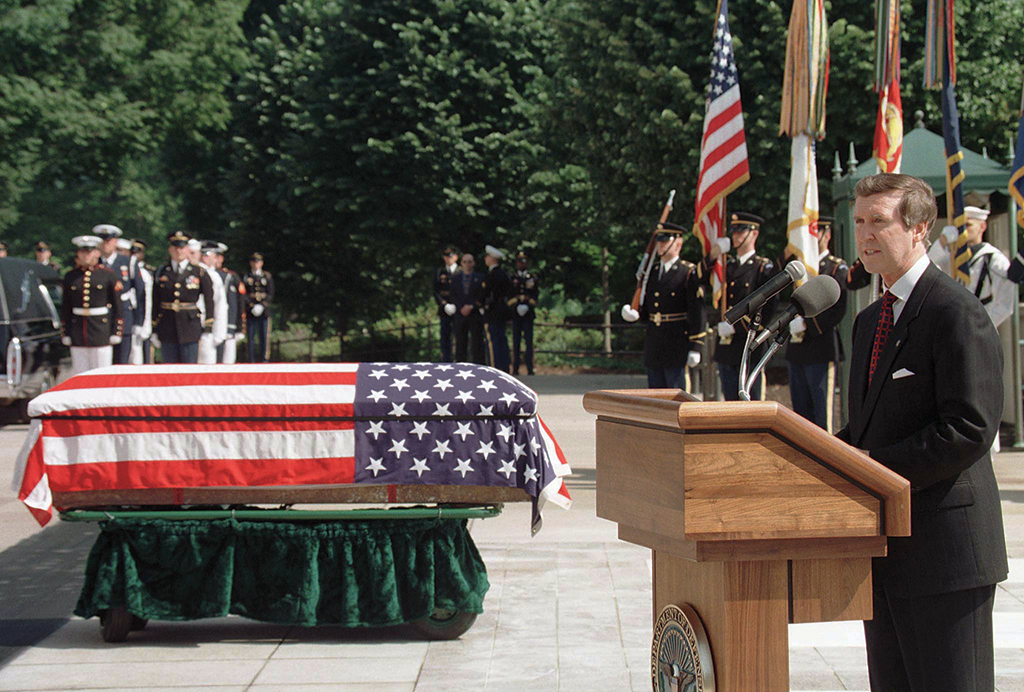
Putting a Name to the unknown Soldier
Ten years later, a former Green Beret, Ted Sampley, wrote an article about the Vietnam unknown for the U.S. Veteran Dispatch newsletter. After reading a book on investigating wartime plane crashes, Sampley had done his own research on the 1972 crash. Citing the bone fragments and pieces of a flight suit, Sampley wrote that he believed Blassie was buried at the Tomb of the Unknown Soldier. He urged that the remains be exhumed and a positive identification be made through DNA testing.
Sampley talked to members of the Blassie family. They were stunned. The family had never been told about bone the fragments or other items recovered at the crash site. Initially, the family decided to remain silent.
The issue again arose when Vince Gonzales, a producer with CBS News, came across the Sampley article. Gonzales began to gather his own evidence and reached the same conclusion that Sampley did. He contacted the Blassie family. After much discussion, the family — at the urging of the airman’s mother, Jean — agreed that the remains should be brought home and granted Gonzales access to the family files. Blassie’s sister, Patricia, then a captain in the Air Force, agreed to speak on camera.
On Jan. 19, 1998, CBS Evening News aired the story. After laying out the evidence, correspondent Eric Engberg reported that the Vietnam “unknown” was Blassie. He said the military had used the secrecy of the selection process to hide that fact from the Blassie family and the public. The family petitioned President Bill Clinton’s defense secretary, William Cohen, to disinter the remains and conduct DNA testing.
A firestorm of controversy erupted. The Veterans of Foreign Wars and American Legion, among other groups initially against the designation of a Vietnam unknown, now asserted that any attempts to disinter the remains would desecrate the tomb. Nevertheless, Cohen directed Rudy de Leon, undersecretary of defense for personnel and readiness, to conduct a study and determine how to proceed.
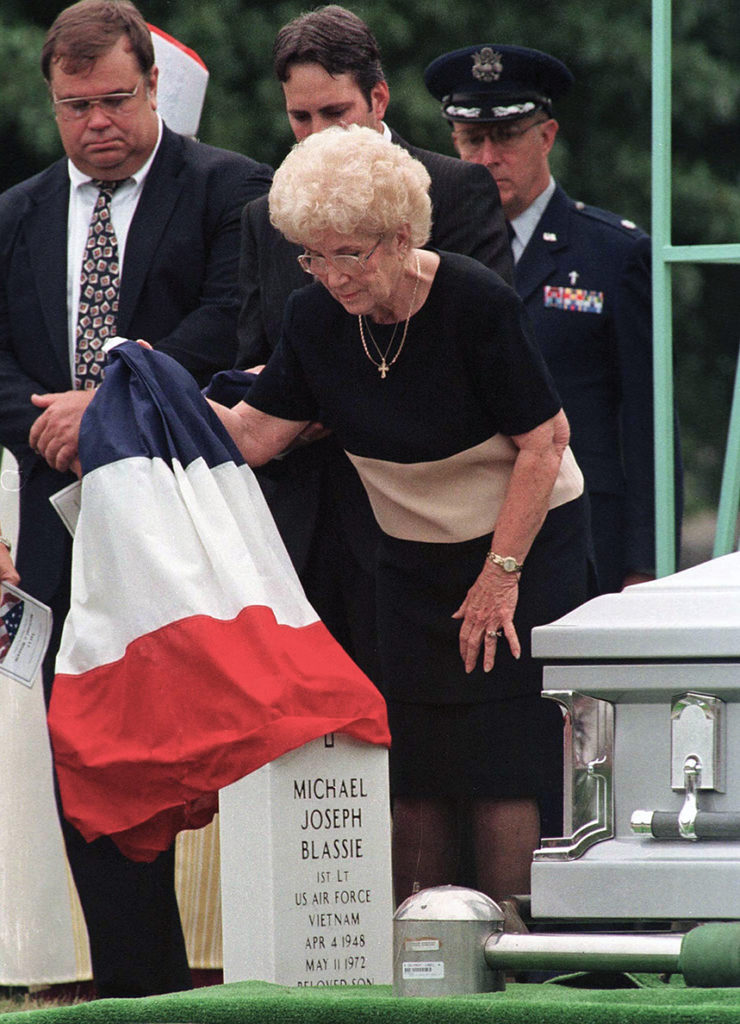
How Blassie Returned to His Family
After a thorough examination of the facts, de Leon recommended that the remains be exhumed and DNA tested.
Cohen agreed. One week later, on the evening of May 13, workers cut into the Vietnam crypt with a diamond-edged saw. The remains were exhumed, draped with a flag and placed on a catafalque.
The following morning, Cohen presided over a ceremony at the tomb attended by the Blassie family and families of eight other pilots killed in the same area where Blassie’s plane was shot down. Sampley was also present. Cohen said that he was reluctant to open the tomb, but added, “We yield to the promise of science, with the hope that the heavy burden of doubt be lifted from a family’s heart.”
The casket was placed in a hearse and transported to Walter Reed Medical Center in Washington. Mitochondrial DNA testing revealed that the X-26 remains were a perfect match with DNA samples provided by Michael Blassie’s mother and oldest sister. On June 30, the Defense Department announced that the Vietnam unknown had been positively identified as U.S. Air Force 1st Lt. Michael J. Blassie.
At the family’s request, Blassie’s remains were flown by a C-130 transport plane to Scott Air Force Base, near St. Louis. On July 11, 1998, Blassie was buried with full military honors in Jefferson Barracks National Cemetery. The attendees included Connally, Blassie’s flight leader, and Parnell, the U.S. adviser at An Loc who had received the bag of remains and watched over them until they were delivered to the morgue in Saigon. Blassie’s casket was carried to the reburial gravesite by an Air Force honor guard. A flight of four F-15 fighter jets flew over, with one soaring skyward in the “missing man” salute. After 26 years in limbo, Blassie was finally home. His name is inscribed on Panel 1W, Line 23 of the Vietnam Veterans Memorial.
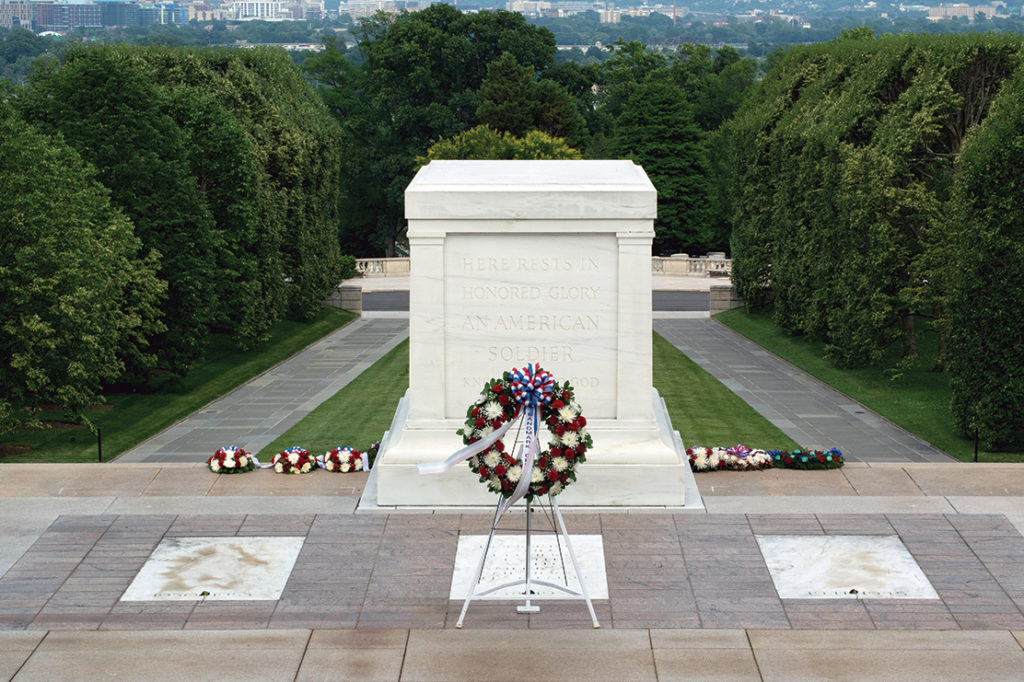
The Aftermath
The Medal of Honor awarded to the Vietnam unknown was rescinded and put on display at Arlington cemetery’s museum. On Sept. 17, 1999, National POW/MIA Recognition Day, the empty crypt of the Vietnam War unknown was rededicated. The original slab over the crypt was replaced with one inscribed with “Honoring and Keeping faith with America’s Missing Servicemen, 1958-1975.” The crypt is meant to represent all unidentified American dead during that period, not just those from Vietnam.
With the burial of Michael Blassie, the era of honoring a new war’s “unknowns” has likely come to a close. Since the Vietnam War, the identities of recovered remains have been confirmed through DNA testing. The Tomb of the Unknown Soldier, however, retains its prominence as hallowed ground and is still one of the most visited sites in the nation’s capital.
James H. Willbanks is a retired Army lieutenant colonel, decorated Vietnam veteran and former General of the Army George C. Marshall Chair of Military History at the Army’s Command and General Staff College at Fort Leavenworth, Kansas. He is the author or editor of 21 books on the Vietnam War and other aspects of military history. He lives in Georgetown, Texas.
This article appeared in the Autumn 2022 issue of Vietnam magazine.
historynet magazines
Our 9 best-selling history titles feature in-depth storytelling and iconic imagery to engage and inform on the people, the wars, and the events that shaped America and the world.


